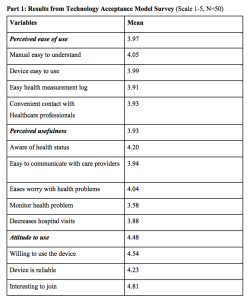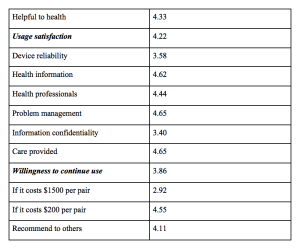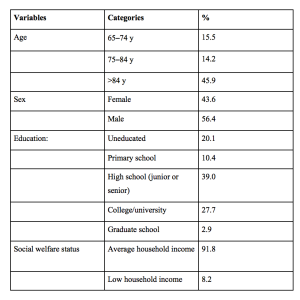Oranicha (Natty) Jumreornvong
Google Glass has a promising future, but surprisingly, it isn’t one dependent upon the younger, urban, and tech-centric generation. To the contrary, Google
Glass will probably find its largest and most loyal customer base in communities dealing with old age. After all, there is a very large population of aging Baby Boomers set on a collision course with all the ills and predicaments that come with age. As Google Glass evolves, evaluation of its adoption to elder care service is vital for further program design and development. This study uses examples and surveys to evaluate the variables influencing the use of technology service programs by the elderly. A questionnaire survey was used to explore the technology acceptance of the elderly in a Google Glass based program. In addition, open-ended questions were used to elicit qualitative information regarding the experience of technology use. The results revealed elderly with higher social welfare statuses, bet- ter health conditions, and more frequent tech usage are usually more open to the idea of using
Google Glass. The correlation results also indicated that elderly who perceived Google Glass favorably as a solution to health problems and intended to use Google Glass also had a better perception toward quality of life regarding their interpersonal relationships and living environ- ment. Some of the more notable examples of the application of Google Glass for the elderly include:
Track a person’s gain and identify mobility problems by signaling a potential fall and broken bones in the near future. Currently, this application is being used by researchers to assist patients with Parkinson’s Disease, a disorder of the brain that leads to shaking and difficulty with walking, movement and coordination. Early warning signs can trigger preventative treatments and healthcare providers would be motivated to try stopping a fall before it happens.
Use as medication reminders. Researchers from Newcastle University and the University of Sussex in the U.K. explored the potential of Glass to deliver discreet treatment reminders to patients and allow patients to make excursions out of the home with confidence. Google Glass was also used to display medication and other treatment reminders right in the patients’ fields of vision. “I was taking two or three different drugs every two hours, different combinations at different times of the day; some with water, some with food, the instructions are endless,” said one participant. “Having a reminder that is literally in your face wherever you are and whatever you are doing would really help.”
Help people suffering from dementia by allowing them to recognize family members and offer simple messages such as, “This is your son, his name is John. Say, “Hello John, how are my beautiful grandchildren?”
Easier communication. In 2006, the Census Bureau reported that 3.6 million Americans were living apart from their adult children. With Google Glass-type devices, adult children could patch into what their parents are doing, even what they are seeing.
Emergency Call. According to data collected by Centers for Disease Control and Prevention, each year, one in every three adults age 65 and older falls. Hence, if there were a problem, a user could say “Help, I’ve fallen and I can’t get up,” and aid would be on the way in seconds.
The possibilities for Google Glass are huge in this older market. Why do companies chase the 19 to 25 year old demographic? Those kids have little money and are most of the time dependent on their parents’money. The Baby Boomers of Generation A are the largest and wealthiest demographic of them all. Boomers have collectively earned $3.7 trillion, more than twice as much as the $1.6 trillion that members of the silent generation did at the same age, according to a new McKinsey Global Institute report. Google’s rush to Google Glass makes perfect sense, if you consider that founders Larry Page and Sergey Brin are 40, and 39 years old, respectively. With every day they have more and more in common with 60 year-olds than with 20 year-olds. Google Glass is an exercise for their future: comforting their old age.
Technology Acceptance
Even though there are exciting prospects for the elderly’s use of Google Glass, the service would be useless if the individuals do not accept it. The most common basis for understanding whether users accept new technology or not rests in the Technology Acceptance Model (TAM), an information systems theory that models how users come to accept and use a technology brought forth by Fred Davis. The five major dimensions include perceived ease of use, perceived usefulness, attitude, intention to use, and actual use. Of the five dimensions, perceived ease of use and usefulness are critical factors that influence the actual technology use.
A study on “Elderly person’s perception and acceptance of using wireless sensor networks to assist healthcare” suggested that elderly people viewed the technology as increasing their life independence.8 The study showed that although many elderly individuals had positive attitudes toward technology, they were still worried about the cost of the equipment and its usability. The result could be imperative to understanding whether this population would use Google Glass in the future because as of right now, the price of Google Glass – $1500 per pair – is quite high. However, Google is planning to release the product costing only $200 retail. The TAM offers an opportunity to evaluate the possibility of Google Glass adoption in the elderly community.
METHOD
A cross-sectional study was conducted using a questionnaire survey approach. To study the acceptance of Google Glass, the structured questionnaire was divided into three sections: open-ended questions to obtain their comments, a survey scaling from 1-5 with higher scores reflecting higher technology acceptance and a questionnaire about personal information to study the correlation between participants’ background and technology acceptance.
Sampling
The elderly participants of a Google Glass-based pilot study on patients’ acceptance towards Google Glass in Maelao Hospital in Thailand were recruited on a one-on-one approach for the questionnaire survey. The inclusion criteria were being 65 years or older and having a clear consciousness and ability to communicate. A total of 50 translated questionnaires were distributed through online surveys to those with access to the internet. For those who did not have internet access, the questionnaires were printed out and given to them directly. Skype was used to conduct the open-ended interviews.
The first part of the questionnaire measured the acceptance of Google Glass based on TAM. While three of the five original dimensions were maintained (i.e., “perceived ease of use,” “perceived usefulness,” and “attitude to use.”), the other two domains were replaced with “user satisfaction”and “willingness to continue use.” A total of 20 questions taken from Technology Acceptance Model were designed based on a 5-point Likert scale that included the following options: strongly disagree (1), disagree (2), neutral (3), agree (4), and strongly agree (5). Higher scores reflected higher acceptance. In addition, open-ended questions were used to gather information about their opinions towards Google Glass and technology adoption. The third part of the questionnaire included personal information such as age, sex, education and social welfare status in order to study the correlation between participants’ background and technology acceptance.
Part 2: Results from Open-Ended Questions
- Do you own a smart phone or other high tech device?
- Google Glass sensors can track a person’s gait and identify mobility problems that signal a potential fall and broken bones in the near future. Do you think this will help trigger pre- ventative treatments?
- How often do you forget to take your medica- tion? Do you think wearing Google Glass will help improve the adherence rate?
- Do you foresee yourself having dementia or are you already suffering from dementia?
- What other applications do you think Google Glass could be useful?
Part 3: Results from Personal Information Questionnaires
DISCUSSION
The answers to the open-ended questions showed that study participants felt Google Glass could increase their health knowledge via the internet, help them find entertainment, help them control health problems, bring them a sense of security, expand their social networks with loved ones, and add to their confidence in health control. On the other hand, the participants noted that Google Glass’ current design does not allow prescribed lens and are unfashionable. However, Google is currently working with Ray Bans and Oakley on new designs that include lens. Nevertheless, when asked about their willingness to use Google Glass, only 13 of the participants expressed they could accept the current cost of $1500 per pair. However, 39 participants said they would accept a cost of $200 per pair. Moreover, there is a correlation that those who own smart phones are more likely to accept Google Glass technology. In addition, many of those who are interested in Google Glass foresee themselves having old age complications like forgetting to take medication, dementia and motor problems. Thus, if they perceive that Glass could be useful in dealing with such issues, they might be even more inclined to adopt Glass.
Perceived usefulness received the highest mean. Most of the participants thought that Google Glass could help them learn about their health status and to control health problems in addition to the entertainment values Google Glass could bring. These positive attitudes were also influenced by their age, education and welfare status. Older participants, those with more educated backgrounds, and those with better economic status tended to have better opinions towards Glass.
Implications
The advancement of wearable technology can help increase the quality of life in the elderly population in terms of increasing healthcare access in case of emergency and improving entertainment experience. Some participants believe that Google Glass could improve telecommunication between doctors and patients without the patients having to go to the clinics. However, some challenges Google Glass needs to overcome include the scarce availability of Google Glass outside the United States, the training of product providers, and costs.
Study Limitations and Suggestions
The interviews and surveys were conducted in Thailand; therefore the cultural context should be taken into consideration. The mean for the results from the technology acceptance model seem to be within the range of 3.9 to 4.5. This could be because of the culture in Thailand, in which most people tend to improve an aspect of their behavior in response to their awareness of being observed. In addition, the mean of each variable does not accounted for statistical discrepancy and outliers. Hence, having a larger sampling size and collecting data from people from different countries may help provide some clarity into the effect of culture and also add greater statistical weight. Moreover, study participants were recruited using a one-on-one approach, which could also cause a self-selection threat for results generalization. In addition, the use of structured questions may not fully gather all aspects of participants’ experience on their use of Google Glass. Based on the answers from the personal question section of the survey, the use of technology may be related to participants’ education and economic status. Thus, future studies should explore the outcomes from different samples such as income level or other domains that characterize ones’ quality of life.
CONCLUSION
Based on research questions and results, several conclusions were reached. First, there is a significant relationship between technology acceptance and their answers to the personal questions specifically on education and welfare status. Elderly who perceived Google Glass as a useful tool to improve their health status and other aspects of living also tended to have smart phones and foresee themselves possibly having complications from old age such as Alzheimer’s, falling due to motor problems or forgetting to take their medications. However, while Google Glass has been highly valued by the participants, their decision to use the product was impeded due to the high cost of the technology. In conclusion, Google Glass has the potential to help solve issues faced by the aging population and hopefully with a lower cost, Google Glass will be widely available not just for the elderly population but also for everyone who wishes to use it as well.
References:
1 Mohney, Gillian. “Researchers See If Google Glass Can Help Parkinson’s Patients.” Abcnews. Abc, 11 Apr. 2014. Web. 4 June 2014.
2 Gregg, Helen. “Study: Google Glass Potentially Helpful for Parkinson’s Patients.” Study: Google Glass Potentially Help- ful for Parkinson’s Patients. Hospital CIO, 14 Apr. 2014. Web. 04 June 2014.
3 Conlin, Jennifer. “Living Apart for the Paycheck.” The New York Times. The New York Times, 03 Jan. 2009. Web. 04 June 2014.
4 Tromp, A.m, S.m.f Pluijm, J.h Smit, D.j.h Deeg, L.m Bouter, and P. Lips. “Fall-risk Screening Test.” Journal of Clinical Epidemiology 54.8 (2001): 837-44. Web.
5 Beinhocker, Eric D. “Why Baby Boomers Will Need to Work Longer.” McKinsey & Company. Mckinsey & Com- pany, 2 Nov. 20. Web. 04 June 2014.
6 FD, David. “Perceived Usefulness, Perceived Ease of Use and User Acceptance of Information Technology.” MISQ 13.3 (1989): 319-40. Web.
8 R, Steel, Lo A, Secombe C, and Wong YK. “Elderly Per- son’s Perception and Acceptance of Using Wireless Sen- sor Networks to Assist Healthcare.” Int J Med Inform 78.12



